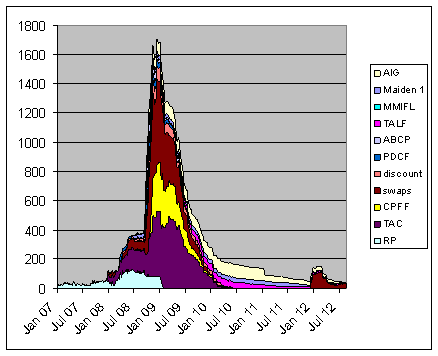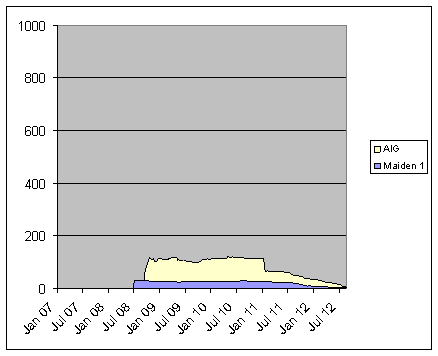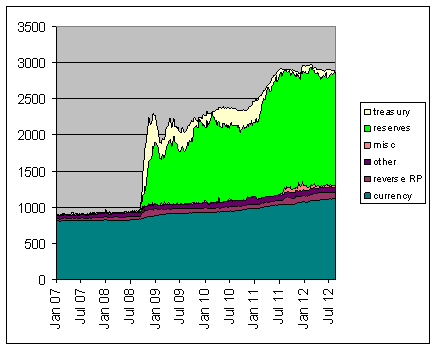The Federal Reserve Bank of New York announced on Thursday that it had sold the last remaining securities from its Maiden Lane III portfolio, successfully closing the chapter on its assistance to insurance giant AIG. I thought this would be a good occasion to review the various measures that the Fed implemented over the last 5 years– what they were attended to accomplish, what they did accomplish, and the significance of Thursday’s announcement.
The first point to emphasize is that the Fed’s strategies for dealing with the financial crunch in 2008 were very different from the tools it subsequently began to adopt in 2009. In 2008, the Fed implemented a series of emergency lending measures which are represented by the orange region in the graph below of the total assets held by the Federal Reserve.

The graph below displays the individual components within that lending category. The most important among these were currency swaps, the Commercial Paper Funding Facility, and the Term Auction Facility. Most of this lending had ended (with all loans repaid with interest) by March of 2010. There was a brief resumption of currency swaps (lending to foreign central banks) as concerns about the European financial situation heightened at the start of this year, though at the moment these are back down to $26 billion, compared to $570 B in November 2008. The Term Asset-Backed Securities Loan Facility (magenta in the graph below) lasted a little longer than most of the other lending, though today it is below $3 B.

A somewhat different class of assets that I’ve also included in the “lending” category of the first graph includes some questionable securities that the Fed acquired in the bailouts of Bear Stearns and insurance giant AIG. The Fed’s holdings of these are broken out separately in the graph below.

The Fed had been following a strategy of gradually selling and writing these off, a process that now is essentially completed. On Thursday, the Federal Reserve Bank of New York issued this statement:
Today’s announcement on ML III follows the successful wind-down of Maiden Lane II LLC (ML II) in February 2012, which resulted in a net gain of approximately $2.8 billion for the taxpayer. It also follows the January 2011 termination of the New York Fed’s extension of credit to AIG, which produced approximately $8.2 billion in interest and fees. When taken together, the total net profit to taxpayers from the New York Fed’s assistance to AIG and AIG-related facilities was $17.7 billion.
I was surprised to see that the Fed ended up making a profit on AIG– my understanding had been that the Fed’s strategy had been to mark these down at a loss over time. I was unable to discover the details of how this ended up favorably for the Fed. Thursday’s statement indicates that more information will be provided on November 23.
But the fact that the Fed ended up making a profit from these transactions is an important detail. The key uncertainty for policy makers at the time (just as it is the key dilemma for the ECB at the moment) was determining whether the crisis is one of illiquidity or insolvency. If the problem is just that assets are temporarily undervalued as a result of the financial panic (i.e., the assets are temporarily illiquid), the central bank can solve the problem by stepping in as a lender of last resort. If instead the problem is that the assets are correctly valued (i.e., the borrowers are fundamentally insolvent), all the central bank can do is transfer these losses from existing creditors to the taxpayer (possibly in the form of an inflation tax). A key indication that the central bank did exactly the right thing is if, as a result of their stepping in, the long-run value of the asset is restored, in which case the Fed would end up making a profit out of the transaction.
Some have criticized the Fed’s emergency lending on the grounds that the Fed took all these extraordinary actions and yet the economy still performed very badly in 2008:Q4 – 2009:Q2. I think this misses the point. I don’t believe that it was ever within the Fed’s (or anyone else’s power) to bring the economy quickly back to full employment. Instead, the purpose of the Fed’s emergency lending was to prevent a very bad situation from becoming even worse than it needed to be. The evidence we now have suggests that the Fed indeed accomplished exactly this. See for example the recent post-mortems by Adrian and Schaumburg on the CPFF and the PDCF.
But let me now return to the first graph to briefly discuss what I see as a very different strategy that the Fed has been following since winding down these emergency lending programs. The Fed replaced the emergency lending with significant growth in its holdings of U.S. Treasury securities, debt issued by Fannie Mae and Freddie Mac, and mortgage-backed securities guaranteed by Fannie and Freddie. These are fundamentally very different from the aggressive lending in the fall of 2008 in that they involved no new transfer of private risk to the taxpayers. The reason is that, before the Fed bought any agency debt or MBS, the U.S. Treasury had already assumed financial responsibility for these agency obligations. Rather than trying to serve as lender of last resort, these more recent measures (sometimes referred to as “QE1” and “QE2”) were instead just intended to help keep long-term borrowing costs low and to make sure that the U.S. did not experience a Japanese-style deflation.
These measures, too, have been criticized on the grounds that, despite QE1 and QE2, the economy continues to disappoint. And here again, I think the critics have missed the point. I again maintain that it is not within the Fed’s power today to bring the economy quickly back to full employment. I nevertheless also believe that deflation– an outright decline in wages and prices– would make our problems even worse. For this reason, I have been a supporter of the Fed now moving ahead with QE3, though my expectations for what this will actually accomplish are low.
Let me end with a look at the liabilities side of the Fed’s balance sheet shown below. Note that the height in this graph is by construction identical at every date to that of the original assets graph. One key liability is the dark green region corresponding to currency held by the public– the green money that you and I carry around. This has increased only modestly despite all the emergency lending, QE1, or QE2. I know some of you have heard again and again that the Fed did all this by “printing money”, but as a physical statement, this simply is not true. Dollar bills with pictures of George Washington (or C-notes with Ben Franklin’s portrait) have never been printed in anywhere near the amount of the Fed’s various actions. In fact, it would be quite a challenge logistically to print them in the quantity necessary to match the surge in Fed assets over the last 4 years.

Instead, the Fed’s assets have been acquired by creating reserves, which are simply credits that banks maintain in their accounts with the Fed. Although banks could, in principle, ask to convert these credits into green currency, for four years banks have instead been content to let the reserves just sit there. Those who insisted that all this “money creation” would lead to runaway inflation have so far at least proved to be spectacularly wrong.
My view is that the Fed never had the power, and lacks the power today, to solve our primary economic problems. However I believe it did have the power, and successfully exercised the power, to prevent our problems from becoming even worse.
- Bulenox: Get 45% to 91% OFF ... Use Discount Code: UNO
- Risk Our Money Not Yours | Get 50% to 90% OFF ... Use Discount Code: MMBVBKSM
Disclaimer: This page contains affiliate links. If you choose to make a purchase after clicking a link, we may receive a commission at no additional cost to you. Thank you for your support!



Thank you for clarity on the Fed’s role over the past four years in trying, initially, to prevent a collapse of credit, and then to provide expansion of credit. The fault of the slow recovery lies not with the Fed but with the President and Congress. We need fiscal policy to match the Fed’s monetary policy. It seems the only adults in the room are at the Federal Reserve.
Absurd post. While Greenspan NEVER tightened monetary policy, Bernanke didn’t loosen monetary policy until March 2009. I.e., Bernanke conducted two separate contractionary money policies precipitating the Great Recession.
Bernanke initiated the first contractionary policy beginning Feb 2006 which lasted for 29 consecutive months, or at first, sufficient to wring inflation out of the economy, but persisting until the economy plunged into a depression. Bernanke initiated a second contractionary policy coterminous with the spike in commodity prices in July 2008.
In effect, as the economy started to collapse, Bernanke tightened monetary policy even further. I.e., Bernanke was responsible for depth of the Great Recession.